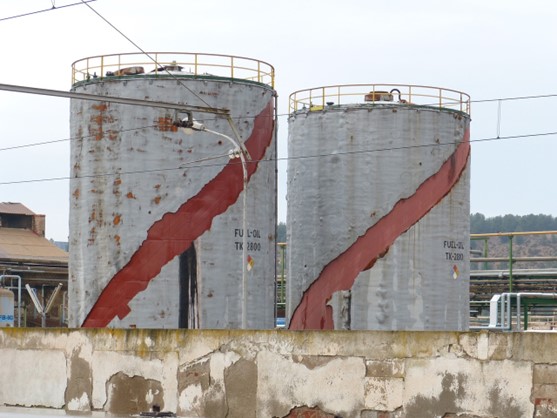Unlocking the Secrets of Effective Oil Storage: How to Choose the Right Oil Storage Tank for Maximum Efficiency
Photo by makamuki0 https://pixabay.com/users/makamuki0-1102736/ on Pixabay https://pixabay.com/photos/tank-factory-industry-oil-tank-6405867/
## Importance of choosing the right oil storage tank
When it comes to storing oil, choosing the right storage tank is of paramount importance. The efficiency and safety of your oil storage system depend on selecting the appropriate tank that meets your specific requirements. An oil storage tank is not just a mere container; it plays a crucial role in preserving the quality of the stored oil and preventing any potential hazards. By understanding the importance of selecting the right oil storage tank, you can ensure maximum efficiency and peace of mind.
Different types of oil storage tanks
Oil storage tanks come in various types, each designed to cater to different needs and applications. The most common types include above-ground tanks and underground tanks. Above-ground tanks are typically larger in size and are suitable for locations where space is not a constraint. They are easy to install and maintain, making them a popular choice for many industrial applications. On the other hand, underground tanks are buried beneath the ground, providing a discreet storage solution. They are often preferred for residential and commercial purposes due to their space-saving nature.
Factors to consider when choosing an oil storage tank
Selecting the right oil storage tank involves considering several important factors. Firstly, you need to determine the required capacity of the tank based on your oil consumption and storage needs. It is crucial to choose a tank that can comfortably accommodate your oil requirements without the risk of overflow or underutilization. Additionally, you should assess the compatibility of the tank material with the type of oil being stored. Different oils have varying properties, and certain materials may react adversely, compromising the integrity of the tank and the oil quality.
Another vital factor to consider is the environmental conditions surrounding the tank. Depending on your location, you may need to account for extreme temperatures, seismic activity, or corrosive elements. It is essential to choose a tank that can withstand these conditions to ensure its longevity and safety. Finally, you must also evaluate your budgetary constraints and the long-term costs associated with maintenance and operation. Balancing these factors will help you make an informed decision and choose the right oil storage tank.
Size and capacity considerations
Determining the appropriate size and capacity of your oil storage tank is crucial to ensure efficient storage and prevent any potential issues. It is essential to consider both your current oil consumption as well as any future growth or changes in demand. A tank that is too small may lead to frequent refilling and disruptions in your operations, while an oversized tank may result in unnecessary expenses and wasted space. By carefully assessing your oil usage patterns and projecting your future needs, you can select a tank that optimally meets your requirements.
In addition to the overall capacity, it is worth considering the shape and dimensions of the tank. The shape can impact the stability of the tank and its compatibility with the available space. The dimensions should also be taken into account to ensure easy transportation, installation, and maintenance. By carefully considering the size and capacity of your oil storage tank, you can avoid any potential bottlenecks and ensure seamless operations.
Material options for oil storage tanks
The material used in constructing an oil storage tank plays a vital role in ensuring its durability, safety, and compatibility with the stored oil. Various materials are used in tank construction, each with its own set of advantages and considerations. Steel is a popular choice due to its strength and resistance to corrosion. It is available in both carbon steel and stainless steel variants, with the latter offering enhanced resistance to certain chemicals and environments. Fiberglass-reinforced plastic (FRP) tanks are another option, known for their lightweight nature and resistance to corrosion. They are particularly suitable for underground applications.
When storing certain types of oil, such as petroleum, it is essential to choose a material that is resistant to the oil’s specific properties. For instance, asphaltic oils may require tanks with special linings to prevent corrosion. Additionally, some oils may be sensitive to temperature changes, necessitating insulation features in the tank. By selecting the appropriate material for your oil storage tank, you can ensure the longevity and safety of both the tank and the stored oil.
Safety features to look for in an oil storage tank
Ensuring the safety of your oil storage system is of utmost importance. Therefore, it is crucial to choose a tank that incorporates essential safety features. One such feature is an overfill prevention system, which prevents the tank from overflowing and causing environmental hazards. This system includes alarms or automatic shutoff mechanisms that alert you when the tank reaches its maximum capacity. Another important safety feature is a leak detection system, which helps identify any potential leaks or spills, allowing for immediate action to prevent accidents.
Additionally, tanks should have appropriate venting systems to prevent the buildup of pressure and ensure proper ventilation. Pressure relief valves and emergency vents are crucial in maintaining the tank’s integrity and preventing any catastrophic failures. It is also advisable to choose tanks with secondary containment systems that provide an extra layer of protection in case of leaks or spills. By considering these safety features, you can prioritize the well-being of your employees, the environment, and the overall integrity of your oil storage system.
Maintenance and inspection of oil storage tanks
Regular maintenance and inspection of your oil storage tank are essential to ensure its continued efficiency and safety. Periodic inspections help identify any signs of wear, corrosion, or damage that may compromise the tank’s integrity. It is advisable to develop a comprehensive maintenance schedule that includes routine inspections, cleaning, and necessary repairs. This proactive approach allows you to address any issues promptly, preventing costly repairs or replacements in the future.
Maintenance tasks may include checking for leaks, assessing the condition of the tank’s protective coatings, and inspecting the fittings and connections for any signs of deterioration. It is also crucial to monitor the oil quality inside the tank, as any degradation can indicate potential issues with the tank or the stored oil. By implementing a regular maintenance and inspection program, you can prolong the life of your oil storage tank and maintain its efficiency and safety.
Regulations and codes for oil storage tanks
When choosing an oil storage tank, it is vital to ensure compliance with relevant regulations and codes. These regulations are in place to safeguard the environment, prevent accidents, and protect public health. Depending on your location and the specific application, you may need to adhere to national, state, or local regulations. Familiarize yourself with the applicable codes and standards, such as those provided by the American Petroleum Institute (API) or the Occupational Safety and Health Administration (OSHA).
Some of the key aspects covered by these regulations include tank design, installation, maintenance, and spill prevention measures. It is important to work with reputable tank manufacturers and suppliers who are knowledgeable about these regulations and can guide you through the compliance process. By adhering to the necessary regulations and codes, you can ensure the legality and safety of your oil storage tank.
Choosing the right location for your oil storage tank
Selecting the optimal location for your oil storage tank is a critical decision that can significantly impact its safety and functionality. The chosen location should comply with local regulations and consider factors such as proximity to buildings, water sources, and environmentally sensitive areas. It is crucial to ensure that the tank is easily accessible for maintenance and inspection purposes.
Additionally, the location should account for any potential risks or hazards that may affect the tank, such as flooding, seismic activity, or fire hazards. It is advisable to consult with experts or professionals who specialize in tank installation and location assessment. Their expertise can help you identify the most suitable location that minimizes risks and maximizes the efficiency and safety of your oil storage tank.
Conclusion
Choosing the right oil storage tank is a crucial step in ensuring efficient and safe storage of oil. By considering factors such as tank type, size, material, safety features, and compliance with regulations, you can make an informed decision that meets your specific needs. Regular maintenance and inspection, along with adherence to relevant codes and standards, further enhance the longevity and safety of your oil storage tank. By unlocking the secrets of effective oil storage, you can optimize your operations, protect the environment, and safeguard your valuable oil resources.
Click here for more information #



